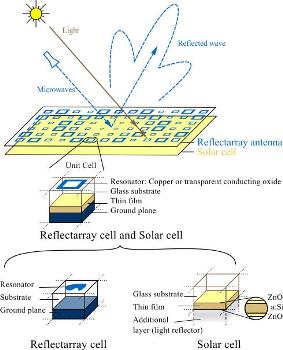Dec 3 2013
Researchers at EPFL have managed to combine antennas and solar cells to work together with unprecedented efficiency in a near future. This is a first step towards more compact and more lightweight satellites. The technology could also be deployed in the autonomous antenna systems used in the aftermath of natural disasters.

Traditionally, telecommunication antennas and solar cells have never really worked well together, as they have to function independently of each other in order to avoid interference. This has an impact on the weight and size of satellites - the surface area has to be large enough for both antenna systems, which emit and receive data, and solar panels, which supply the electricity.
For his master project, Philippe Dreyer, who is part of Julien Perruisseau-Carrier Group, has been working on ways to combine solar cells and antennas. In collaboration with the Transparent Conductive Oxides group (TCOs) which is part of the Photovoltaics and Thin Film Electronics Laboratory (PV-Lab), he has developed a mixed surface that allows both the antenna and the photovoltaic cell to perform extremely efficiently.
This could substantially reduce the volume, weight and cost of satellites. But not only that. Mobile and autonomous communications systems are often necessary to keep in contact with people in the wake of a natural disaster. This new technology would make these systems lighter and therefore easier to carry around. "Our device could also support flexible implementation. It could be folded up so that it isn't deployed until the relief area has been reached," states Julien Perruisseau-Carrier, who supervised the project.
A basic structure
For their study, the researchers used so-called reflectarray (RA) antennas, which have the advantage of being flat, relatively cheap and highly efficient. These antennas were combined with thin-film amorphous-silicon solar cells developed by PV-Lab.
In the device, a set of conductors (resonators) is placed on top of the solar cells. This layering makes it possible for the cells to maintain up to 90% of their photovoltaic efficiency.
"It is not the first time that scientists try to merge solar cells and antennas. But the advantage of our method is that it allows preserving good performances for both the antenna and the photovoltaic system, while leaving intact the solar cell's original structure. You just have to take existing solar cells, and to add a conductive layer", says Julien Perruisseau-Carrier.
Devices have been developed with two different types of antenna: one with a copper conductor, which lets no light rays through where the metal is deposited, but guarantees very high antenna efficiency, and one with a so-called transparent conductor (TCOs), which gives priority to solar-cell efficiency.
In future applications, the type of antenna chosen will therefore depends on whether you want to give priority to the antenna or to solar-cell efficiency. "We are very happy with our results, especially since it started as a simple Master project, which was then extended by only a few months", says Julien Perruisseau-Carrier.
Tomorrow's antennas and solar cells
Neither device chosen for this research is in widespread use as yet, but they already look promising for applications in space. Thin film amorphous Si Solar cells, which have been under study for more than 20 years in the PV-Lab, have significant benefits: they are light and resistant to radiation. "Their efficiency is lower than the traditional multi-junction solar cells, but they allow better power/weight performances", state Christophe Ballif and Monica Morales Masis , from PV-Lab.
As for the antennas used in the study, they are referred to as the technology of the future. "NASA selected a satellite with these antennas and solar panels for a technology demonstration mission planned for 2014," states Julien Perruisseau-Carrier. For this mission, NASA is using a platform with solar panels on one side and antennas on the other. Being able to combine these two devices would have saved on surface area, for example. "